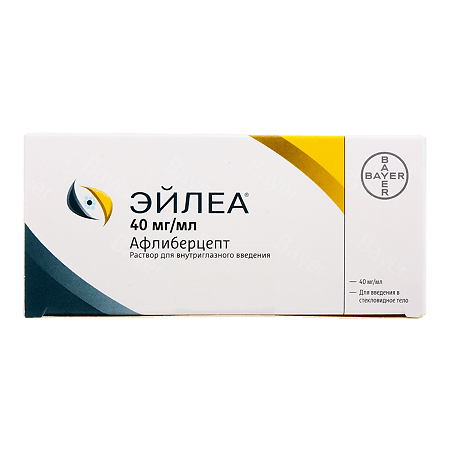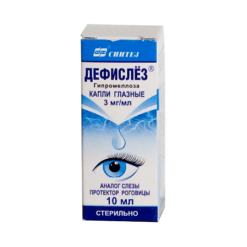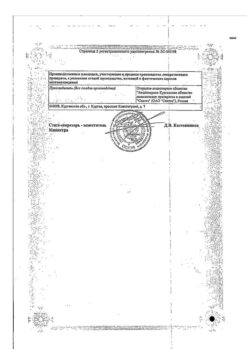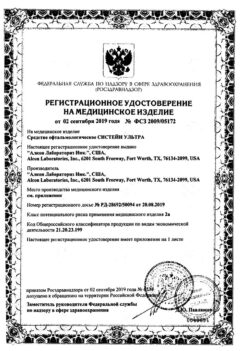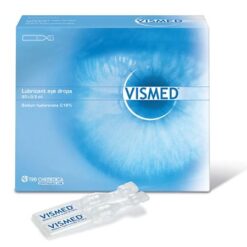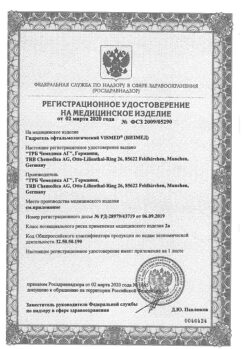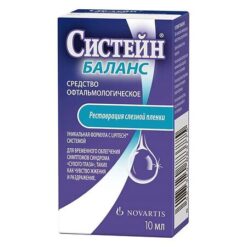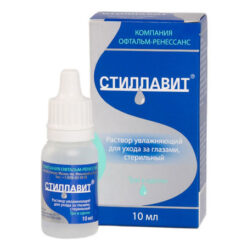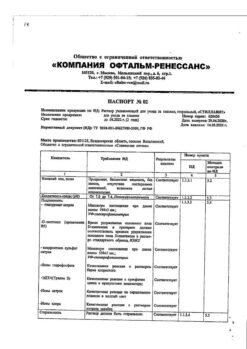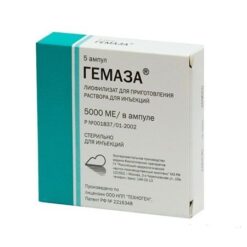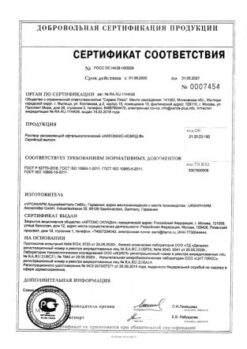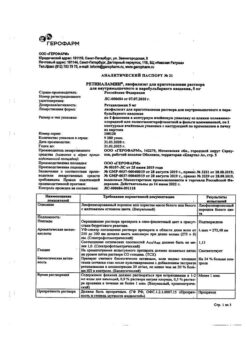No products in the cart.
Eilea, 40 mg/ml 0.1 ml in kit
€1.00
Out of stock
(E-mail when Stock is available)
Description
Aflibercept is a recombinant hybrid protein composed of fragments of the extracellular domains of human VEGF receptors 1(VEGFR-1) and 2(VEGFR-2) coupled to an Fc-fragment of human immunoglobulin G (IgG1).
Aflibercept is produced by Chinese hamster ovary K1 cells (JCH; SNO) using recombinant DNA technology.
Aflibercept acts as a soluble trap receptor that binds VEGF-A (vascular endothelial growth factor A) andPIGF (placental growth factor) with higher affinity than their natural receptors, and thus can inhibit the binding and activation of these related VEGF receptors.
The mechanism of action
Vascular endothelial growth factor A (VEGF-A) and placental growth factor (PIGF) are members of the VEGF family of angiogenic factors that have potent mitogenic, chemotactic actions against endothelial cells and increase vascular permeability. VEGF acts through two types of tyrosine kinase receptors, VEGFR-1 and VEGFR-2, present on the surface of endothelial cells. PIGF binds only to VEGFR-1, which are also present on the surface of leukocytes. Excess VEGF-A activation of these receptors can lead to pathological neovascularization and excess vascular permeability. In these processes, PIGF can exhibit synergism with VEGF-A and also stimulates leukocyte infiltration and vascular inflammation.
Pharmacokinetics
The Eilea® drug is injected directly into the vitreous for local effects.
Absorption
After intravitreal administration, aflibercept is slowly absorbed into the systemic bloodstream, where it is found mainly as an inactive, stable complex with VEGF; and only free aflibercept can bind endogenous VEGF.
In a frequent sampling pharmacokinetics study in 6 patients with neovascular TMD, maximum plasma concentrations of free aflibercept (systemic Cmax) for 1 to 3 days after intravitreal injection of a 2 mg dose were low, averaging approximately 0.02 µg/mL (range 0 to 0.054), and were undetectable two weeks after injection in virtually all patients. Aflibercept does not cumulate in plasma when administered intravitreal every 4 weeks.
Distribution
. Mean maximum plasma concentrations of free aflibercept are approximately 50-500 times lower than the concentrations required to inhibit the biological activity of VEGF in the systemic bloodstream by 50% in animal models in which changes in blood pressure were observed after reaching a concentration of free aflibercept in the systemic bloodstream of about 10 µg/ml, pressure returned to normal values when the concentration was reduced below 1 µg/ml. The average plasma concentration of free aflibercept after intravitreal injection of 2 mg aflibercept in patients is expected to be more than 100 times lower than the concentration of aflibercept required to bind half of systemic VEGF (2.91 µg/mL) in healthy volunteers. Thus, the development of systemic pharmacodynamic effects, such as changes in blood pressure, is unlikely.
(The magnitude of the mean Cmax of free aflibercept in plasma according to the results of pharmacokinetic supplemental studies involving patients with OCVS, OVVS and DMO was in the range of 0.03 to 0.05 mcg/mL, individual values did not exceed 0.14 mcg/mL. Subsequently, plasma concentrations of free aflibercept declined to values below or close to the lower limit of quantification usually within one week. After 4 weeks, concentrations were undetectable in all patients before the next use.
Metabolism
Because Eilea® is a protein drug, no studies have been performed on its metabolism.
Elevation
Free aflibercept binds to VEGF to form a stable inert complex. Like other large proteins, both free and bound aflibercept are expected to be eliminated from the body by proteolytic catabolism.
Pharmacokinetics in Different Patient Groups
Elderly Patients
There are no special conditions to follow. There is limited experience with use in patients with DMO over 75 years of age.
Children
The Eilea® drug is not used in this group of patients for the indications of wet AMD, DCVS, OVVS and DMO.
Patients with impaired renal function
No specific studies have been performed with patients with impaired renal function receiving Eilea®.
The analysis of pharmacokinetic data from the VIEW2 study showed that 40% of patients with impaired renal function (24% mild, 15% moderate and 1% severe) showed no difference in plasma concentrations of the active substance after intravitreal administration every 4 or 8 weeks.
Similar results were obtained in patients with PCVS in the GALILEO study and patients with DMO in the VIVID-DME study.
Indications
Indications
Eilea® is indicated for the treatment of adult patients:
Active ingredient
Active ingredient
Composition
Composition
1 ml of the drug contains:
Active ingredient: aflibercept 40,000 mg.
Excipients: sodium dihydrophosphate monohydrate 1.104 mg, sodium hydrophosphate heptahydrate 0.537 mg, sodium chloride 2.338 mg, sucrose 50.000 mg, polysorbate 20 0.300 mg, water for injection to 1 ml.
One vial contains 100 µl of solution, which is equivalent to 4 mg of aflibercept.
How to take, the dosage
How to take, the dosage
The contents of the vial should only be used for one injection.
Eilea® should only be injected by a physician who is qualified and experienced in intravitreal injections.
Neovascular (wet) age-related macular degeneration (wet AMD)
The recommended dose of Eilea® is 2 mg of aflibercept, which is equivalent to 50 µL of solution.
Treatment with Eilea® begins with three consecutive monthly injections followed by one injection every two months. The control between the injections is not required.
After 12 months of Eilea® treatment the interval between injections can be increased based on the results of changes in visual acuity and anatomical indexes. In this case, the treating physician should schedule follow-up examinations, which may be more frequent than the injections.
Macular edema due to retinal vein occlusion (central vein (CVC) or its branches (BVC))
The recommended dose of Eilea® is 2 mg of aflibercept, which is equivalent to 50 µl of solution.
After the initial injection, treatment is given monthly. The interval between two injections should be at least one month.
If there is no improvement in visual acuity and anatomical signs after continuous treatment, treatment with Eilea® should be stopped.
Monthly injections continue until maximum visual acuity is achieved with no signs of disease activity, for which three or more consecutive monthly injections are required.
The therapy can be continued in the usual and extended mode with gradually increasing intervals between injections to maintain the stable visual acuity and anatomical parameters achieved, but there are insufficient data to establish the duration of the intervals. If visual acuity and anatomical indices deteriorate, the intervals between injections should be shortened accordingly.
The monitoring and choice of treatment regimen is determined by the treating physician based on the patient’s individual response.
Monitoring of manifestations of disease activity may include a standard ophthalmologic examination, functional diagnosis, or imaging studies (optical coherence tomography or fluorescence angiography).
Diabetic macular edema (DME)
The recommended dose of Eilea® is 2 mg aflibercept, which is equivalent to 50 µL of solution.
Therapy with Eilea® begins with one monthly injection for the first five months, with injections every two months thereafter. Monitoring between injections is not required.
After 12 months of Eilea® treatment the interval between injections can be increased based on the results of visual acuity and anatomical indicators. The schedule of control examinations is made by the attending physician.
If the visual acuity and anatomical findings indicate a lack of benefit from current treatment, Eilea® therapy should be discontinued.
Patients with hepatic and/or renal impairment
There have been no specific studies involving patients with hepatic and/or renal impairment receiving Eilea®.
On the basis of available data, no dose adjustment is required in these patients (see section on Pharmacokinetics).
Patients in the elderly
There are no special conditions to be observed. There is limited experience in treating patients over 75 years of age with DMO.
Children
The safety and effectiveness of Eilea® have not been studied in children and adolescents. Eilea® is not indicated for use in this group of patients.
Interaction
Interaction
There have been no studies regarding drug interactions.
The combined use of photodynamic therapy (PDT) with verteporfin and Eilea® has not been studied, therefore the safety profile is unknown.
Particular indications:
Reactions due to intravitreal administration
The association of intravitreal injections, including aflibercept injections, with the development of endophthalmitis, vitreous inflammatory reaction, regmatogenous retinal detachment, retinal rupture, iatrogenic traumatic cataract has been found (see See section “Side effects”). Appropriate aseptic injection technique should always be followed during administration of Eilea®. In addition, patients should be monitored for up to one week after the injection to detect the first signs of inflammation and to initiate the necessary therapy. Patients should be informed of the need to immediately inform the physician of any symptoms indicative of the development of endophthalmitis or any of the other reactions mentioned above.
There have been cases of increased intraocular pressure in the first 60 minutes after intravitreal injections, including Ailea® injections (see section “Adverse effects”). Special precautions are necessary when treating patients with poorly controlled glaucoma (Eilea® should not be injected if the intraocular pressure is ⥠30 mmHg). In all cases, intraocular pressure and optic disc perfusion should be monitored and appropriate therapy administered.
Immunogenicity
Because Eilea® is a protein with therapeutic properties, there is a possibility of immunogenicity (see section “Adverse effects”). Patients should be advised to inform their physician of any signs or symptoms of intraocular inflammation, such as pain, photophobia, or conjunctival or pericorneal injection, which may be clinical manifestations of hypersensitivity to the drug.
Systemic effects
Systemic adverse events have been reported following intravitreal injections of VEGF inhibitors, including hemorrhage outside the visual organ and arterial thromboembolism. There is a theoretical risk of association of these events with VEGF inhibition. There are limited data on the safety of aflibercept use in patients with CVA, CVA, or DME with a history of stroke, transient ischemic attack, or myocardial infarction in the 6 months before initiation of therapy. Caution should be exercised when treating these patients.
Other
As with intravitreal administration of other anti-VEGF drugs for TMD, CABG, OVVS, and DMO, the following should be taken into consideration:
Populations with limited data
The experience with DME in patients with type 1 diabetes mellitus, patients with glycated hemoglobin levels greater than 12%, and patients with proliferative diabetic retinopathy is limited.
The use of Eilea® in patients with active systemic infections or in patients with concomitant eye diseases such as retinal detachment or macular tear has not been studied. There is no experience with Eilea® in patients with diabetes mellitus and uncontrolled hypertension. This should be considered by the treating physician in the management of these patients.
Data from preclinical studies
In the preclinical studies of repeated-dose toxicity, the effects of the drug were observed only at systemic exposures significantly greater than the maximum exposure in humans after intravitreal administration at the dose intended for clinical use, indicating that these results are of little significance in clinical practice.
There have been no studies to investigate the mutagenic or carcinogenic potential of aflibercept.
The effect on the ability to drive trans. sr. and mech:
The use of alea® has minimal effect on the ability to drive vehicles and use machinery due to possible temporary visual impairment associated with both the injection and the examination procedure. If the patient has temporary visual impairment after injection, the patient should not drive or operate machinery until visual clarity is restored.
Contraindications
Contraindications
Side effects
Side effects
2957 patients who participated in the seven phase III studies comprised the safety assessment population. Of these, 2,356 patients received the recommended dose of 2 mg.
Serious adverse reactions associated with the injection procedure were reported in fewer than 1 case per 2,200 intravitreal injections of Eilea® and included blindness, endophthalmitis, retinal detachment, iatrogenic traumatic cataract, vitreous hemorrhage, cataract, vitreous detachment and increased intraocular pressure (see “Special Considerations” section).
The most common adverse reactions (in at least 5% of patients treated with Eilea®) included subconjunctival hemorrhage (24.9%), decreased visual acuity (10.7%), eye pain (9.9%), increased intraocular pressure (7.1%), vitreous detachment (6.8%), floating vitreous opacities (6.6%), and cataracts (6.6%).
The safety data below include all adverse reactions noted in seven phase III studies in the treatment of wet AMD, OVD, OVD and DMO indicating the possibility of a causal relationship to the injection procedure or the drug.
The adverse reactions presented below are listed according to frequency of occurrence in clinical trials and with systemic organ class. The frequency of occurrence is defined as follows: very common (⥠1/10), common (⥠1/100 and < 1/10), infrequent(⥠1/1,000 and < 1/100), rare (⥠1/10,000 and < 1/1,000), very rare (< 1/10,000).
Within each group, adverse reactions are presented in decreasing order of severity.
Immune system disorders
Infrequent: hypersensitivity***
Visual organ disorders
Very common: retinal hemorrhage, decreased visual acuity.
Often: Retinal pigment epithelium rupture*, retinal pigment epithelium detachment, retinal degeneration, vitreous hemorrhages, cataracts, nuclear cataracts, subcapsular cataracts, cortical cataracts, corneal erosion, corneal microerosions, increased intraocular pressure, blurred vision, floating vitreous opacities, corneal edema, vitreous detachment, pain at the injection site, pain in the eye, feeling of a foreign body in the eye, lacrimation, edema, hemorrhages at the injection site, pitting keratitis, injecting the conjunctiva, injecting the conjunctiva of the eyeball.
Infrequent: blindness, endophthalmitis**, retinal detachment, retinal rupture, iritis, uveitis, iridocyclitis, lens opacity, corneal epithelium defect, irritation at the injection site, abnormal eye tissue sensitivity, eyelid irritation, suspended blood cells in the anterior chamber.
Rarely: iatrogenic traumatic cataract, inflammatory reaction from the vitreous body (vitreitis), hypopyon.
* Conditions known to be associated with wet AMD. Observed only in studies with wet TMD.
** Endophthalmitis with culture and non-seeding.
*** Including allergic reactions.
Description of individual adverse reactions
In phase III studies in wet TMD, an increased incidence of subconjunctival hemorrhage was noted in patients receiving antithrombotic drugs. The increased incidence was comparable in patients receiving ranibizumab and Eilea®.
Arterial thromboembolism (ATE) is an adverse event potentially associated with systemic inhibition of VEGF.There is a theoretical risk of arterial thromboembolism after intravitreal administration of VEGF inhibitors.
As defined by the Antiplatelet Trialists’ Collaboration, the term ATE includes nonfatal myocardial infarction, nonfatal stroke, and death due to circulatory events (including Sudden Unexplained Death Syndrome).
The prevalence of ATE in phase III studies for wet AMD (VIEW I and VIEW2) over 96 weeks of study was 3.3% (60 of 1,824 total) in the group of patients receiving Eilea® compared to 3.2% (19 of 595) in patients receiving ranibizumab (see section on Pharmacodynamics). The corresponding value in the phase III trials on DME indications (VISTA-DME and VIVID-DME) over the first 52 weeks of the study was 3.3% (19 of 578) in the group of patients treated with Eilea® compared to 2.8% (8 of 287) in the control group (see “Pharmacodynamics”).
The prevalence of ATE in the phase III studies for the OCVS indication (GALILEO and COPERNICUS) over 76/100 weeks of the study was 0.6% (2 of 317) in patients who received at least one dose of Eilea®, compared to 1.4% (2 of 142) in the patient group who received only mock injections (see Pharmacodynamics” section), while in the phase III VIBRANT trial over 52 weeks of the study, this value was 0% (0 of 92) in patients treated with Eilea® compared to 2.2% (2 of 92) in the control group (see “Pharmacodynamics” section). One of these patients in the control group received backup treatment with Eilea®.
Like all therapeutic proteins, Eilea® has immunogenic potential.
Overdose
Overdose
Symptoms
In clinical studies, doses up to 4 mg at 1-month intervals have been used; individual cases of overdose have been observed with a dose of 8 mg.
Overdose with administration of a larger volume of solution may result in increased intraocular pressure.
Treatment
In case of overdose, intraocular pressure should be monitored and if necessary the treating physician should initiate adequate therapy to correct it.
Additional information
| Shelf life | 2 years. Do not use after the expiration date. |
|---|---|
| Conditions of storage | Store at 2 to 8 ° C, in a light-protected place. Do not freeze. Store out of the reach of children. The unopened bottle may be stored at a temperature not exceeding 25°C for up to 24 hours before use. |
| Manufacturer | Vetter Pharma-Fertigung GmbH & Co. |
| Medication form | solution |
| Brand | #Н/Д |
Related products
Buy Eilea, 40 mg/ml 0.1 ml in kit with delivery to USA, UK, Europe and over 120 other countries.

